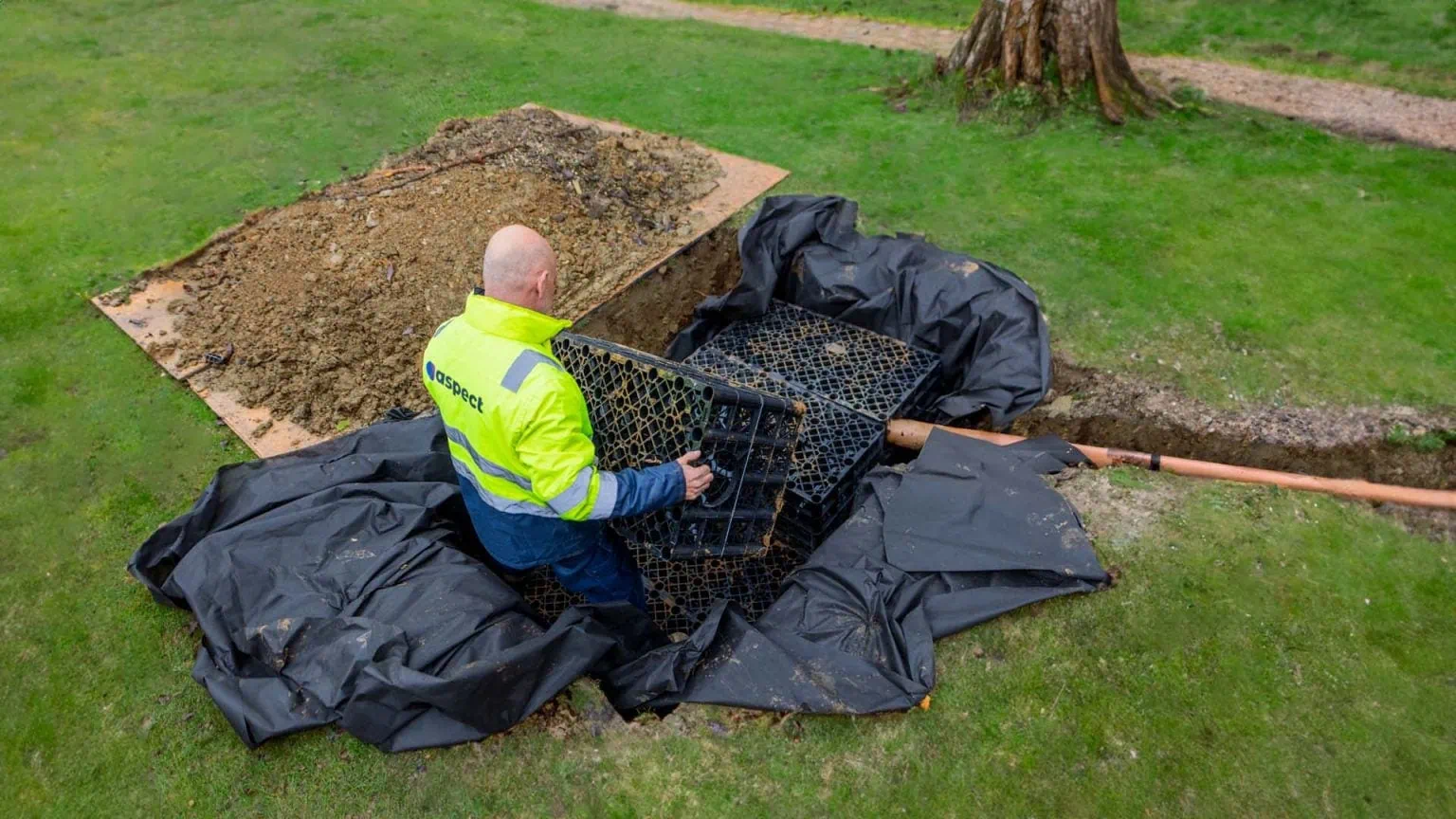Garden drainage solutions/systems to fix waterlogging
If your outdoor space is waterlogged, there are a range of garden drainage solutions available to choose from. Not only does standing water make your garden look unsightly and difficult to use, but flooding can stop plants and grass from growing.
Before you think about installing a garden drainage solution, there are several things to consider.
Our drainage experts have provided their advice about waterlogged gardens and paving, including a comparison of solutions that can get your outdoor space back to its former glory.

Why is my garden or patio waterlogged?
Waterlogging in a garden occurs when the ground is saturated and water can no longer infiltrate the soil. This saturated soil can happen naturally whenever there’s heavy rain. Factors like soil structure and the ability for water to run off will impact the extent of soil saturation.
Other factors can increase the risk of waterlogging:
- Height of the property above the local water table
- Presence of clay soils that reduce the ability for water to infiltrate
- Local topography can mean that water flowing overland collects in low-lying areas
- Existing drainage network might be damaged and not reach the sewer system
- Rainwater from roofs is not draining through gutters and downpipes correctly
Book a drainage engineer

Our drainage engineers have the tools and experience to install a garden drainage system.
- Half-hour rates from £42.75 + VAT
- Priority attendance within 1 hour
- £10 off when you book online
- Fixed pricing for planned work
Keeping rainwater out of sewers
During periods of increased rainfall in the UK, the sewage networks can struggle to cope with the amount of water entering the pipes. This can mean that untreated sewage is discharged into rivers and the sea to prevent the sewage network from backing up and flooding.
For this reason, tight building regulations exist that limit the circumstances where connecting a rainwater garden drainage solution to the main sewage system is allowed.
Dedicated rainwater drains
Lots of properties have a combined rainwater and foul water system. However, a garden drainage solution could only be connected to an existing drainage system, if there’s a dedicated rainwater system that runs to the property boundary.
If you’re unsure how the foul water and rainwater drainage connects at your property, you should get a drain mapping survey carried out. The report can be provided as evidence to your local authority or wastewater company, and is useful to have when it comes to selling a property.
If you don’t have a dedicated rainwater drainage system, a soakaway can be installed.
Remember, a rainwater harvesting system is also an environmentally friendly way to collect and store rainwater. It might help to prevent waterlogging in your garden, and the water can be used in times of drought.
Garden drainage solutions at a glance
Once you have considered how you will remove the excess water from your garden, it’s time to consider the garden drainage solutions that are most suitable for your needs. For example, simple aeration of a lawn is unlikely to work for regular flooding. So, a long-term solution is often the best way to deal with excess water.
The three most effective garden drainage options that can be installed for all soil types are:
- Soakaways
- Channel drains
- French drains
Soakaway drainage
Where there’s waterlogging, a soakaway is often required to create greater drainage capacity. You can install a soakaway beneath a garden that’s prone to waterlogging on its own or in addition to a wider garden drainage solution, such as channel drainage or French drains. It’s a simple but effective solution to prevent the excess water from reaching the rivers and sea by instead, collecting water and allowing it to infiltrate the soil gradually.
Soakaways can be made using concrete or plastic crates lined with geotextile sheeting, backfilled and compacted with gravel and soil beneath the garden. Crate sizes can vary depending on your needs. A common size for residential use is around one to two cubic metres, but their size should be calculated based on the surface area collecting rainfall. They will require digging equipment and the removal of soil to install.
The good thing about this solution is that once installed, you won’t even know it’s there.
Channel drainage
Channel drainage sits just below the ground’s surface. It’s covered with a grill and sits flush against the ground to collect water from above ground. This type of drainage works best for paved or concrete areas, as it prevents water from running from your paved area and onto your garden. They can either run into a rainwater drainage system, if you have one, or into a soakaway.
Tip: We recommend calling a certified engineer to install all of the drainage systems mentioned in this guide. If they aren’t installed correctly, they could be ineffective or even cause damage to your property.
French drains
French drains can be used to take water from the surface and infiltrate the soil further down. On their own, French drains won’t resolve a sizable waterlogging problem. But, used in conjunction with a soakaway or dedicated rainwater drainage system, they can get the water away from the surface more effectively.
While channel drainage is installed close to the surface and moves water somewhere else, a French drain works differently. The drainage pipe is installed around 250 to 500 millimetres below the surface with holes in it to allow water to infiltrate the soil.
If you’re installing a French drain under a garden, it can be backfilled with gravel and topped with soil and/or turf to make it invisible. Alternatively, it can be installed next to a paved area to prevent water from running off onto your garden, like channel drainage, but topped with gravel.
Other garden drainage solutions
Depending on the severity of your waterlogging problem, other options can be considered. Accept an ongoing waterlogging problem and create a bog garden with plants that love permanently wet conditions.
In the most severe cases, a pumping station can also be an option. This requires installing a small holding tank or chamber in the garden that pumps to a rainwater or sewage system. However, this is often the most expensive solution for preventing waterlogging with higher equipment costs and electrical considerations.
Keep water in our gardens
Remember, we can all do our bit to protect our environment, and our outdoor spaces at home are where most of us can start. Storing rainwater for use elsewhere and preventing it from being discharged into the sewers using the likes of a soakaway can help to reduce pollution in our seas and rivers, as well as create a healthier environment for your garden.
If you need advice or are interested in installing garden drainage solutions, our drainage engineers have years of experience to help.
Areas we cover

As a guide, we offer a comprehensive range of drainage services throughout Greater London and the South East of England. Our service area includes Bedfordshire, Berkshire, Buckinghamshire, East Sussex, Essex, Hampshire, Hertfordshire, Kent, Oxfordshire, Surrey, and West Sussex.
If you need our drainage services outside of this coverage area, we may still be able to help. Our scheduling team will check availability and see if an expert can be scheduled for your location.
Was this article helpful?
Think we could improve this article? Please let us know